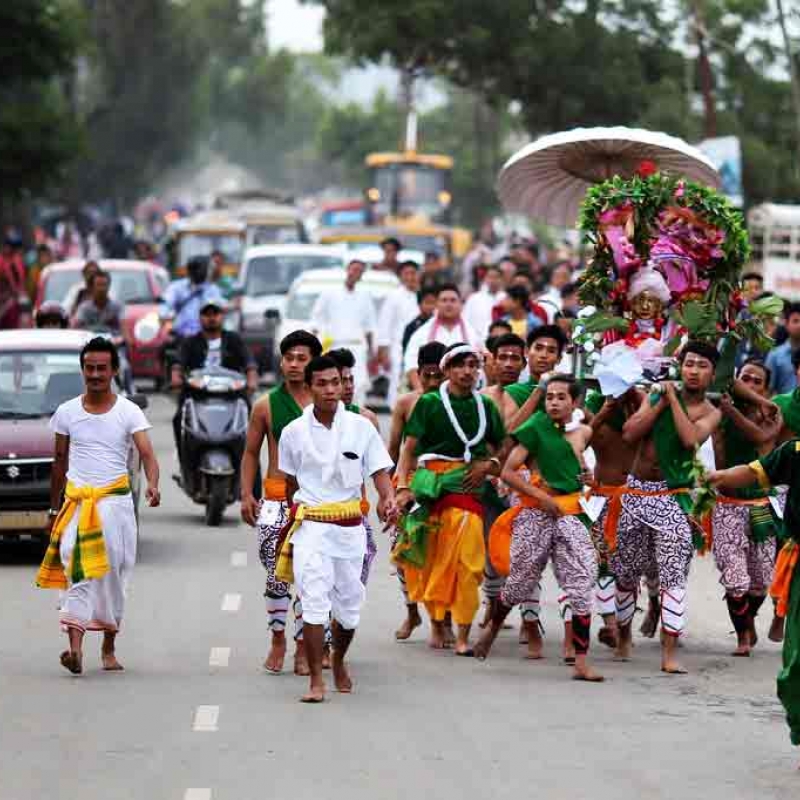Introduction
Lai Haraoba is a religious festival celebrated by the Meitei people who are largely settled in and around Manipur. It is held at neighbourhood shrines dedicated to the local umanglai deities. These is a generic category of deities within the religious faith of the Meiteis that pre-dates the period of Hinduisation. There are no particular dates assigned in the Meitei calendar for the festival. However, it is observed in the months between February and May-June. When the time of year arrives, shrines set their own dates for the festival. The ritual that is a part of the event is not a single day affair. Theoretically, it can be as short as three days or can even exceed a month. In other words, the duration of the festival is flexible and differs across shrines. Each shrine usually decides the date and duration of its festival. The Lai Haraoba festival is celebrated not only in Manipur, where the Meiteis are primarily based, but also in neighbouring areas where the Meitei people have settled–such as Assam, Tripura, Bangladesh, and Myanmar.

Outsiders know Lai Haraoba for its dance tradition (Fig.1). The elaborate ritual dance traditions have been the source of the Manipuri dance form and have been instrumental in inspiring the famed Manipuri Ras lila, which has the distinction of being one of the classical dances of India. The discourse on dance has had a significant impact on how the Lai Haraoba has been perceived, talked about, and represented in the wider world as well as within Manipur. However, the Lai Haraoba is much more than just dance and music, or even religion. It has a prominent place in the cultural lives of the people and has been crucial in reasserting Meitei ethnic cultural identity in the face of its identification with Hindu religious and cultural identity. The Lai Haraoba and its associated traditions reflect the cosmic universe of the Meiteis and the ethos of their society. The festival sheds light on its material culture.
The Lai Haraoba festival is striking to behold because of its visual spectacle. It is as much about the religious rites and beliefs, as it is about a visual display of Meitei customs and traditions.
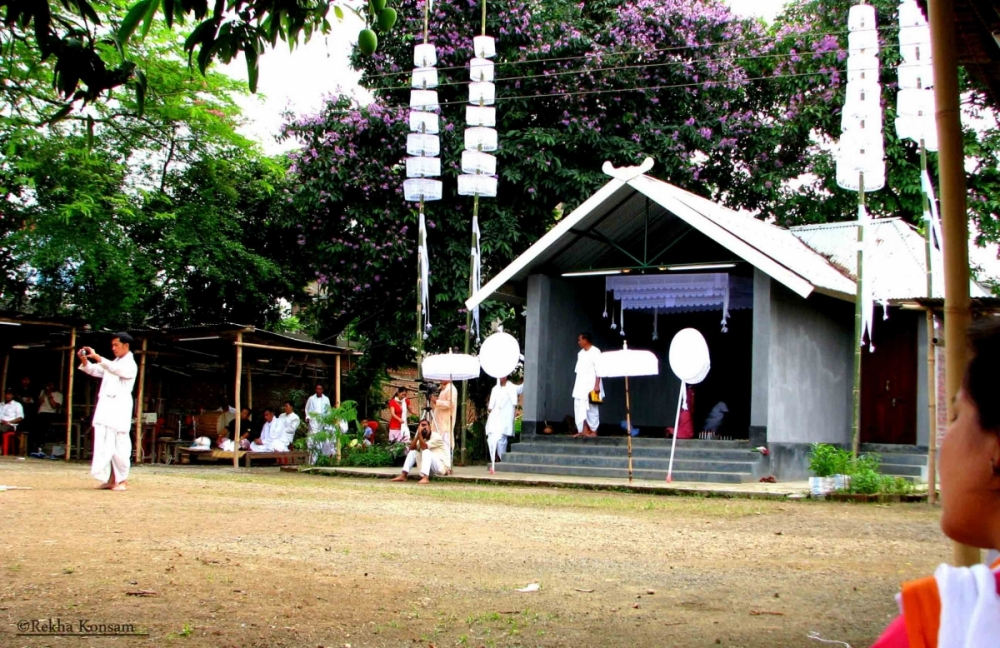
The Umanglai Deities and the Lai Haraoba Festival
The Lai Haraoba is also known as the Umanglai Haraoba, referring to the collective name of the deities in whose honour the ritual event is hosted (Fig.2). It is an important religious festival celebrated primarily in the Meitei community. The ritual event honours the resident Umanglai deities, who are venerated in the local neighbourhood. They are worshipped in shrines maintained by the community. These resident deities are revered as protectors and guardians of the areas where they are located. The festival is held in the precincts of these shrines and the entire community engages in the preparations.
The generic category of Umanglai includes a plethora of divine personalities. There are more than 300, including ancestral deities, legendary forefathers, lineal deities, and other prominent deities in the Meitei pantheon. There have been various attempts to classify the numerous deities included in this category on the one hand while on the other the term ‘Umanglai’ has been the focus of much discussion. There have been different interpretations of the term ‘Umanglai’, just as there have been debates and discussions seeking to address the translation of the term ‘Lai Haraoba’ itself.
Elangbam Nilakanta Singh translates Lai Haraoba as the ‘merry making of the gods and goddesses’. This meaning has been co-opted by many others. Saroj Nalini Parratt and John Parratt, on the other hand, translate it as ‘pleasing of the gods’, as the title of their co-authored work announces. This translation is in keeping with J. Shakespeare’s (1913) translation with the modification of making it plural as against Shakespeare’s own usage in the singular sense. This modification, as they explain, is to take into account the fact that the Lai Haraoba rituals do not address a single deity but are directed at a couple; hence, the use of the plural. Against these interpretations, the explanation forwarded by the practitioners of the ritual is that it is derived from the episode of lai hoi laoba (lit. the cry of ‘hoi’) in the Meitei creation myth. This is the moment when the universe is revealed and this interpretation is credited to the late Ng. Kulachandra, the previous head of the Manipur Pandit Loishang.
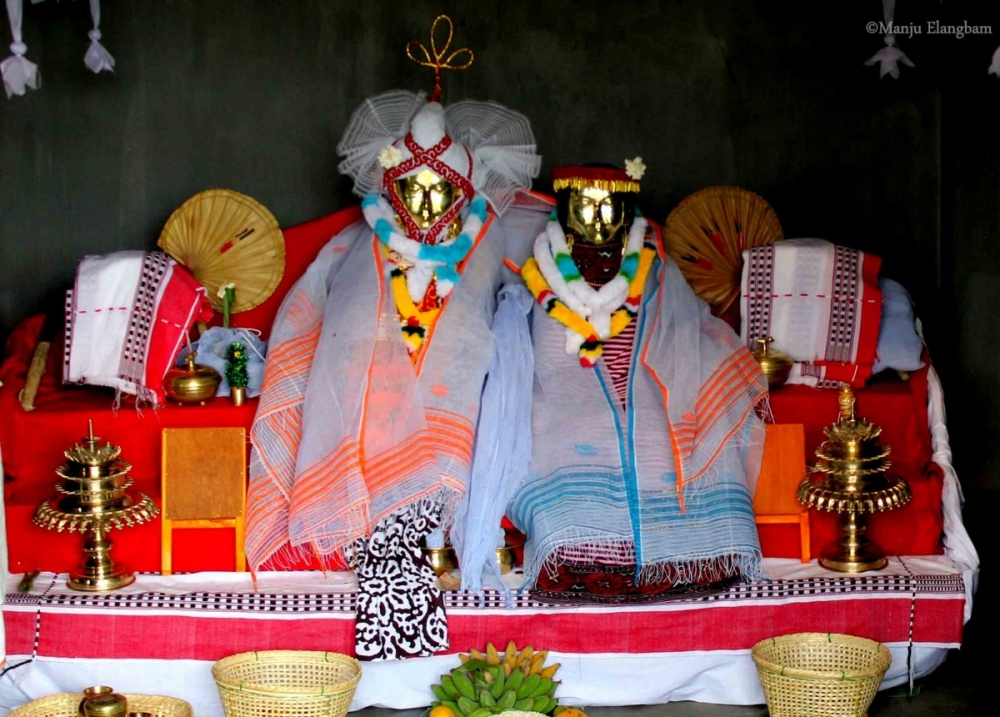
The rituals address a male and a female deity as presiding deities with the honorifics of Lainingthou and Lairembi/Lairemma, respectively (Fig.3). Thematically, the rituals revolve around creation. In the Meitei belief, the cosmos was created by the command of the supreme god. He is known by various names—Tengbanba Mapu (or Taibangpanba Mapu) and Atiya Sidaba. As Claude Levi-Strauss says, the myths can spiral–meaning that there is no beginning and no end to the tales. Hence, while some of the accounts of creation begin with Atiya Sidaba or Tengbanba Mapu, other accounts go back to Atingkok and to Amamba. Amamba is the infinite darkness from where life begins. The Lai Haraoba is a celebration of creation and references various myths about the origins of different Meitei religious thoughts. The beginnings of dance itself are explained within the dance rituals of the Lai Haraoba. The Meitei word, jagoi, is believed to have been derived from chat-koi, referring to the circumambulatory dance rituals of the laibou segment, which is an essential part of the Lai Haraoba rituals.
The mythological references, worldviews, ritual practitioners, and traditions embodied are distinctly different from the Hindu religious practices of Manipuri Vaishnavism. Hence, it is significant that while there are associations with Hindu deities and myths explaining the origin of Lai Haraoba, these are not readily accepted by majority of the Meitei populace, especially today. It is important to note that these accounts were once popular within certain circles; and they persist, even today, in some circuits. Interestingly, they are largely absent in accounts by Meitei people themselves.
Types of Lai Haraoba Ritual Traditions
While Lai Haraoba is observed across the state, significant differences have been noted across the region. As Guru Achoubisana tells us in his interview (https://www.youtube.com/watch?v=Ku-rqvypO10&t=79s), efforts were made to chart out these differences. They have been broadly classified into categories and each of their distinctive features highlighted.
The different types of the Lai Haraoba tradition are:
Kanglei Haraoba, celebrated in and around Imphal. The term Kanglei is derived from Kangla which lies in the heart of Imphal. The main deity addressed is Pakhangba. A special item in this variant is the ritual of Khoriphaba’s search for a ‘bride’.This is performed by a maibi (spirit medium) who invokes the spirit of the deity Khoriphaba to perform this ritual selection of a ‘bride’. The festival then concludes with the nongarol, which marks the ascent of the divine presence.
Moirang Haraoba is celebrated in and around the Moirang region, which lies towards the southern part of the valley. The main deity addressed is Thangjing. Here, in addition to the evergreen leaves of langthrei (a predominant offering in the Kangla variant), leisang, another evergreen shrub, too is offered. The distinctive feature of this variant is the inclusion of the Khamba-Thoibi duet dance. The festival concludes with the hymn of tengtharol (lit. song of lamentation) which marks the ascent of the deities.
Chakpa Haraoba does not strictly constitute a variation by itself. It is a grouping of the various forms of the festival, as celebrated by the different Chakpa groups inhabiting different villages. The hand movements are simpler and the structure less complex. It involves sacrificial practices. The variants commonly referred to are those practices in the villages of Andro and Phayeng. Rituals such as numit kappa (lit., ‘shooting of the sun’) have been observed only in Andro. It is cited as one of the unique features of the Andro tradition. Similarly, the Phayeng tradition also has certain key observances, such as the rite of lai phagi tounaba, which are not practised elsewhere.
Though the aforementioned are the most commonly recognised variants, there is also the Kakching Haraoba, which refers to traditions observed in the Kakching region to the east of Imphal. A unique feature is the ritual of ngaprum tanba (lit., ‘the hunting of eel’) on the last day. Opinions are divided as to whether or not it should be accorded a separate category; some prefer to think of it as part of Kanglei while others feel that it ought to be subsumed under Chakpa Haraoba as a sub-category. Dr. Kh. Ratankumar Singh recognises it as a separate category. One must, however, keep in mind that while these are important differences in the observance of the ritual, each shrine often has certain unique observances or conducts that are part of its customary practices.
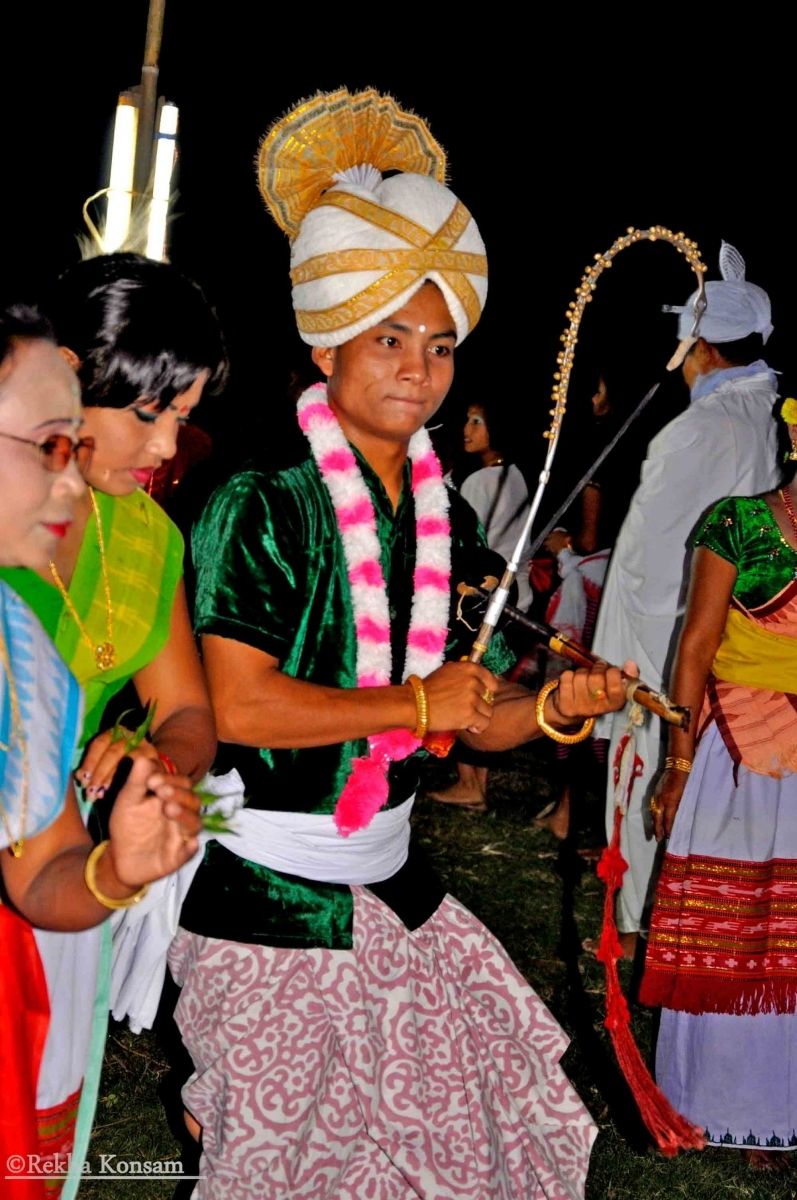
The Ritual
The rituals of the Lai Haraoba are officiated by ritual practitioners belonging to three different lines of specialised practice of the religion that existed prior to the institutionalisation of Hinduism in the Meitei society. These three lines of ritual practice are maiba, maibi, and asheiba (also referred to as pena, the music tradition of the indigenous fiddle). Of the three, the traditions of the maiba and asheiba are open only to men (Fig.4) while that of the maibi, which is largely that of spirit mediumship, are open to women (Fig.5).
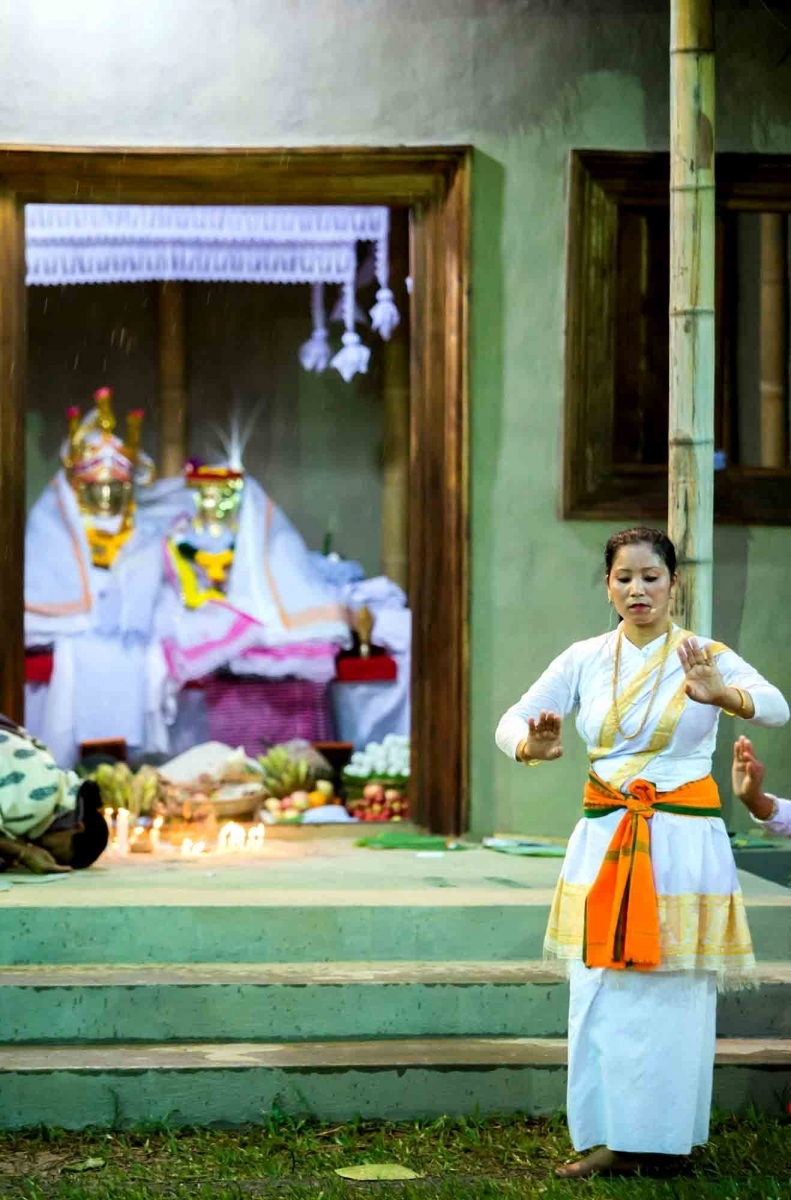
The description outlined here is based on the Kanglei form of Lai Haraoba. The rituals are elaborate, covering various spheres as part of a ritualised practice. It can be understood as composing of three parts. These three constituent parts denote the beginning, the days in between, and the end—Lai eekouba, Haraoba, and Lairoi, respectively. The rites of the Lai eekouba mark the descent of the Lai (the Meitei term for god), while those of the Lairoi mark the ascent. The days in between the beginning and the end follow a similar ritual structure. The number of these in-between days is flexible giving the festival an elastic duration, ranging from three days to over three weeks.
Eekouba Rituals
The set of rituals in the Lai eekouba primarily focuses on ‘drawing up’ a sacred presence and installing it in the shrine for the duration of the festival. The preparation for the Eekouba rites includes opening the doors of the shrine, which normally remains shut through the year. This is called lai thong hangba (lit., ‘opening of the shrine doors’), and takes place on an auspicious day just before the day scheduled for the Eekouba invocations. The shrine is cleaned after the opening, and sacred images and objects are gathered for the event. The utensils are cleaned, clothes required for the ceremonies are washed, sacred images for the festive assemblage are taken out, and so on. In some cases, preparations start even before the opening, such as making rice beer to be used for the event. This is ritualised with specific songs and processes.
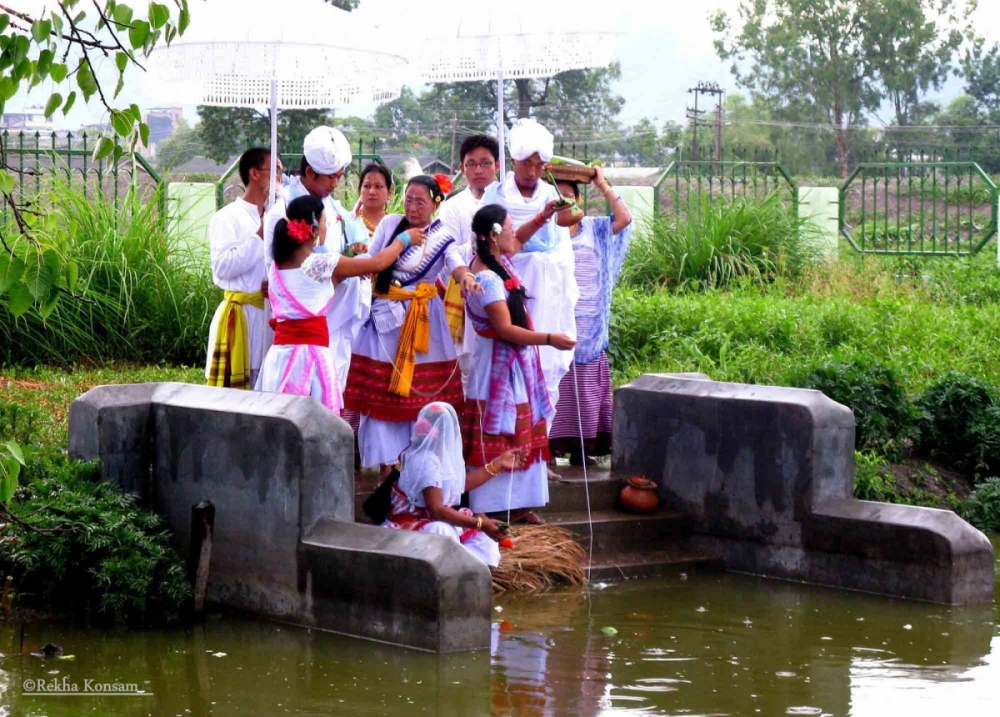
The drawing up of the sacred in the rite of eekouba usually takes place through water (Fig.6). It is often performed at a water source—either a nearby pond or river. A procession starts from the shrine to the site of eekouba. The drawing up is performed there by the water. Offerings are made and deities invoked. The transfer of the sacred is performed by a maibi, who invokes the sacred with incantations and by ringing her hand-bells. In the process, the person (spirit medium) performing this rite often becomes possessed and enters a trance-like state. The utterances she makes in this state are taken as messages from the spirits/deities. The sacred objects and images are given life only with the transference in the Eekouba. The procession then returns to the shrine where the sacred objects are placed in the installations and the layout is completed (Fig.7). The day ends with a rite (naosumba) by the pena fiddle player who plays his instrument, and sings to put the deities to rest for the night. This is the first day of the festival.
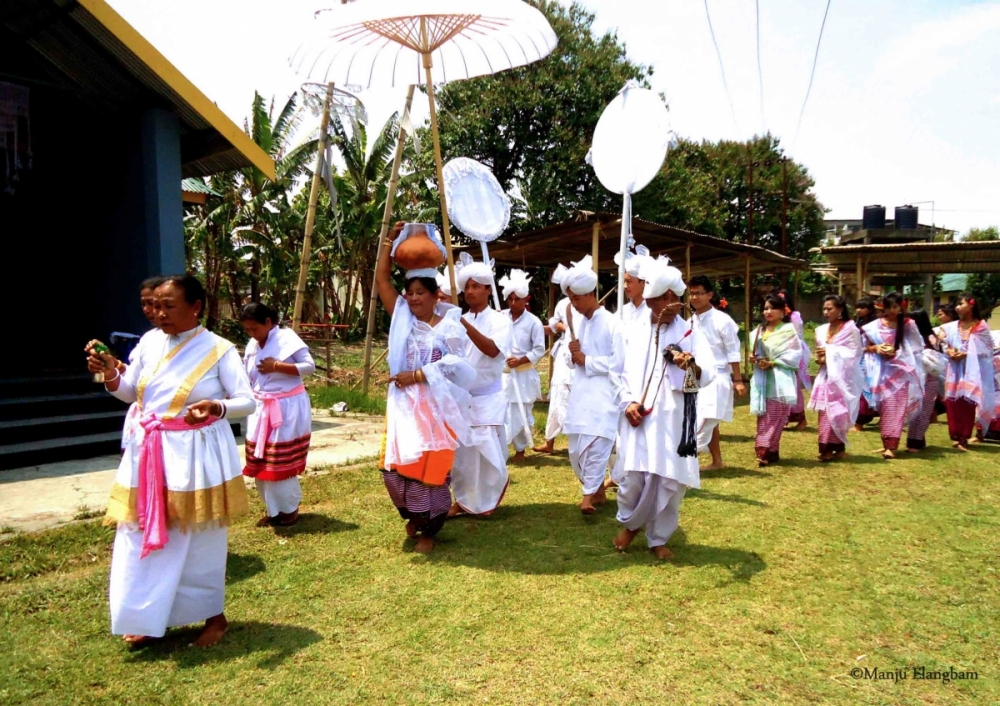
Haraoba Rituals
The second day begins with the awakening rite (yakeiba), wherein the pena fiddle player performs to awaken the deity. This takes place early in the morning. A series of rites and chants are performed, such as bathing (iru sadengba), removal of redundant or suppressive energies (anam-aha kokpa), etc. People stream into the shrine with offerings of fruits, rice, grains, flowers, incense sticks, and candles. The morning invocations are performed and offerings made.
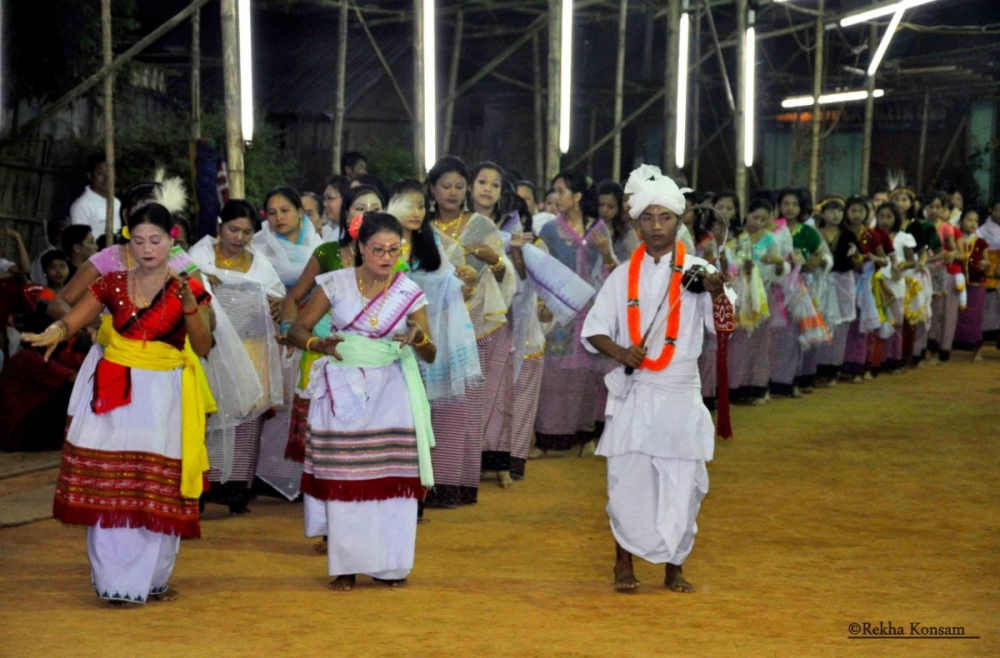
The core of the ritual takes place in the evening. Music and dance are prominent parts of these rituals. However, its significance is not just as performance, but constitutes the ritual itself. The evening ritual commences with the offering of flowers, lei langba. This is traditionally the duty of the person in charge of the flowers or his assistant. The maibis pay obeisance before beginning the core rituals with the dance of thougal jagoi (Fig.8). In the words of Arambam Lokendra, this is ‘an acknowledgement of their bounden duty for the Lai or a presentation of themselves before the Lai for the day’s duties at hand’.[1] The songs of this dance speak of the glory of the presiding deity. The dance is led by the maibis and they are joined by members of the community. Men, women, and children can all participate. This is followed by the laibou segment of the Haraoba rituals.
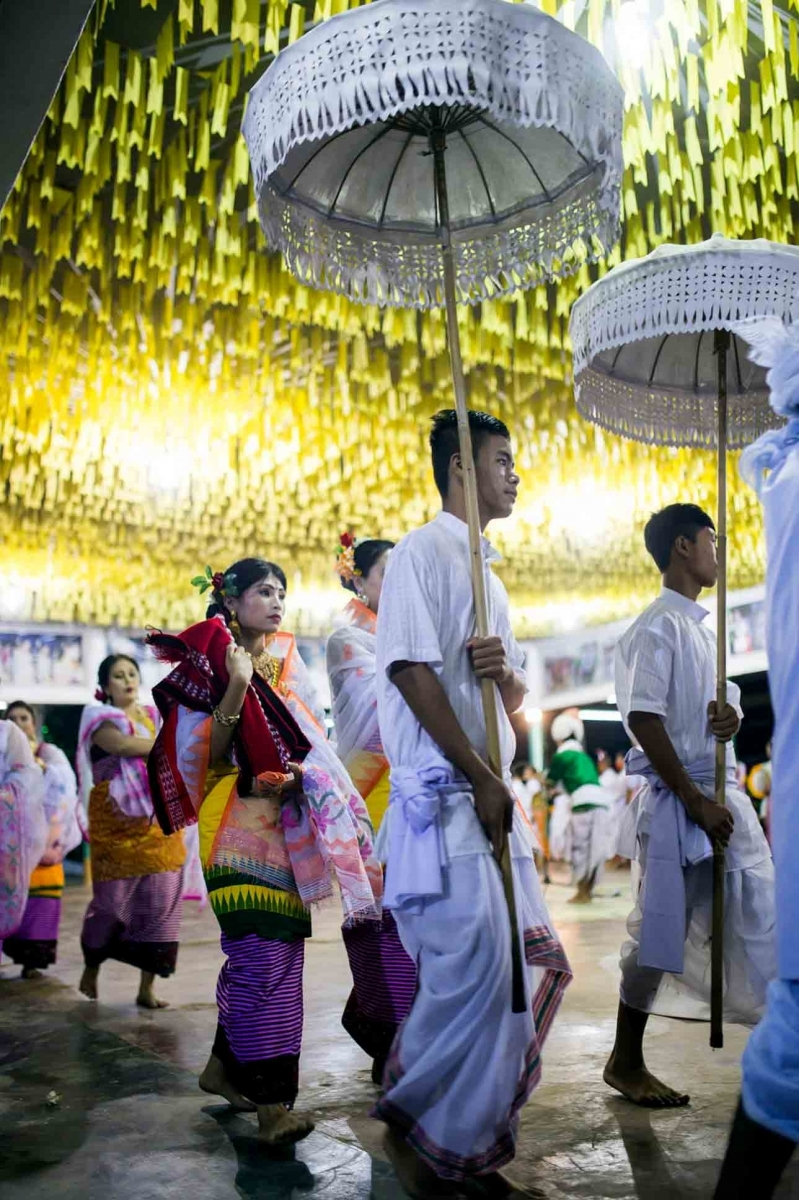
The laibou rituals are at the core of the Lai Haraoba (Fig.9). The precursor to this segment is the laying of the laibou la, a banana leaf with a small offering and the sacred leaves of langthrei (Burma agrimony) at the centre of the performing area, in front of which a group of maibis perform the ritual dance drawing out the sacred presence into the performance space. This is the dance of laiching jagoi (lit., ‘the dance to draw out the deities’). The performance of this short dance ritual is traditionally accompanied only by the strumming of the pena fiddle—there is no song (Fig.10). This is followed by the singing of hoi laoba (shouting ‘hoi’). This is sung collectively by participants who follow the maiba’s lead. The singing style here is similar to that of the wakol laoba, (concluding song) sung to close the day’s rituals. It is distinct from other ritual songs. Arambam Lokendra refers to this characteristic style as antiphonal songs.
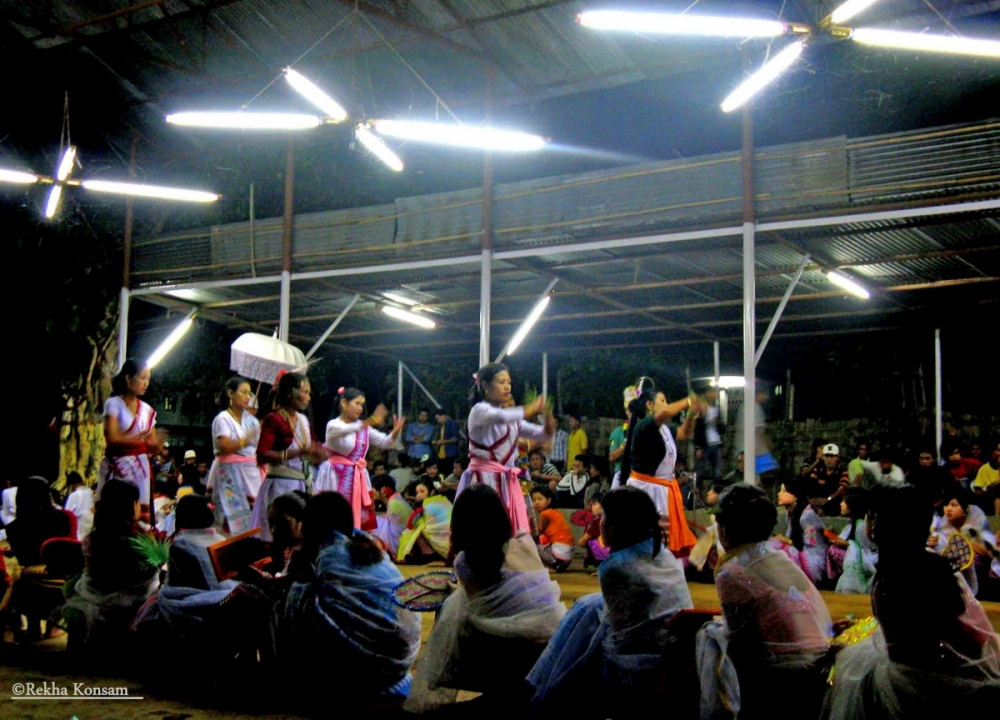
Laibou rituals are performed in a procession that circumambulates the performance area. It is about the creation of the human body and birth, construction of the house, cultivation, spinning and weaving, etc. It is performed by a procession of people bearing sacred objects, led by the maibi. The procession begins in front of the shrine and circumambulates the performing area, paying respect to the four directions and their associated deities. The dance ritual begins with the creation of the body. The dances of the maibi are detailed, to account for making every part of the human body—from carving the eyes and drawing the brows to drawing lines on the soles of the feet. The baby is then ‘born’ and brought up with loving care and all his basic needs are met. The child soon requires clothing. To respond to this need, the hillside is cleared to cultivate cotton which is then processed and woven into clothes. To protect against the elements, a house is constructed for which frames are made and mud is prepared to plaster the walls. When the child grows up, he goes fishing. Fishing is interpreted as a symbol of carnal desires. At each point of this detailed ritual segment, there are explicit references to material culture.
The laibou is followed by the padon jagoi, which is performed by the maibis in a single line, led by one of the seniors. They draw out serpentine patterns in the performance area. What follows is a series of rites centred around the phibul (ball of cloth) and the phijang, the piece of white cloth held along four poles. The four poles constitute the ritual umbrella and banners. The four edges of the cloth are held at each of the four poles. Two maibis, carrying a sacred object each, dance around the four poles, under the shelter of the cloth. At the end of the series of rites, the cloth is gathered together and deposited back to the shrine. Parratt and Parratt refer to this segment as the canopy cycle.
The day’s rituals end with the drawing out of the serpentine patterns, called lairen mathek chatpa by participants in the procession. Following this, the sacred objects are deposited back in the shrine and the wakol song sung. The deities are finally put to rest for the day with the pena performing the naosumba (lullaby).
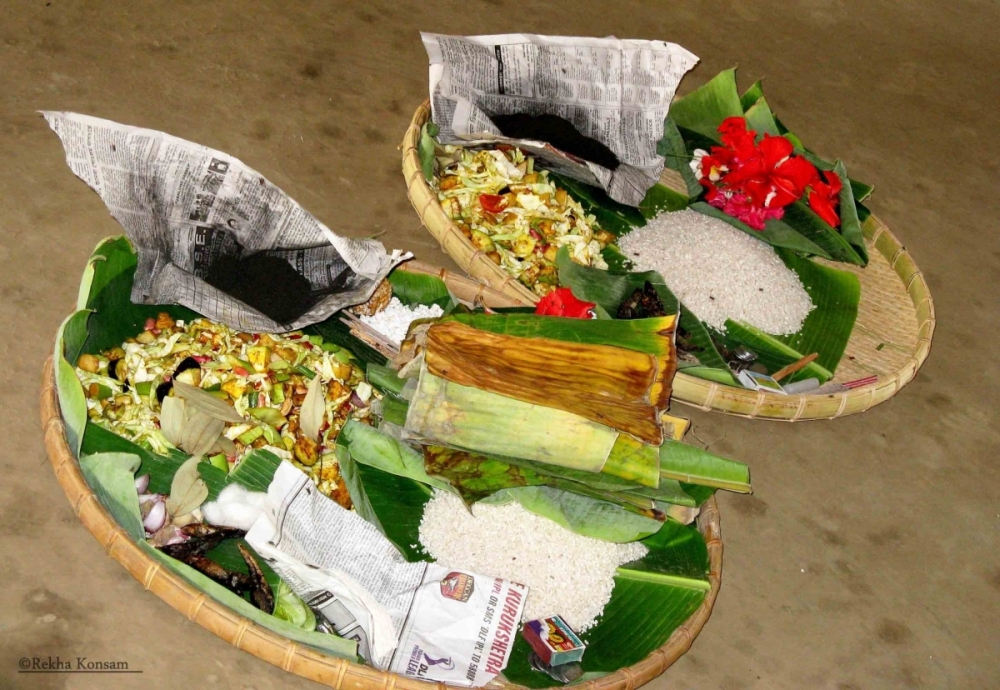

There are some rites that are performed only on select days and not observed everyday. Some of these are the saroi khangba rites, in which devotees offer food items to lesser spirits to feed them off (Fig.11). Another is the kanglei thokpa wherein the spirit of the deity Khoriphaba is specifically invoked. This rite is popularly referred to as lai nupi thiba which literally means the ‘search for the bride’ (Fig.12). A more visible one is the street procession of lai lam-thokpa, when the procession that takes place within the sacred precinct is carried outside with full fanfare, by throngs of people (Fig.13).
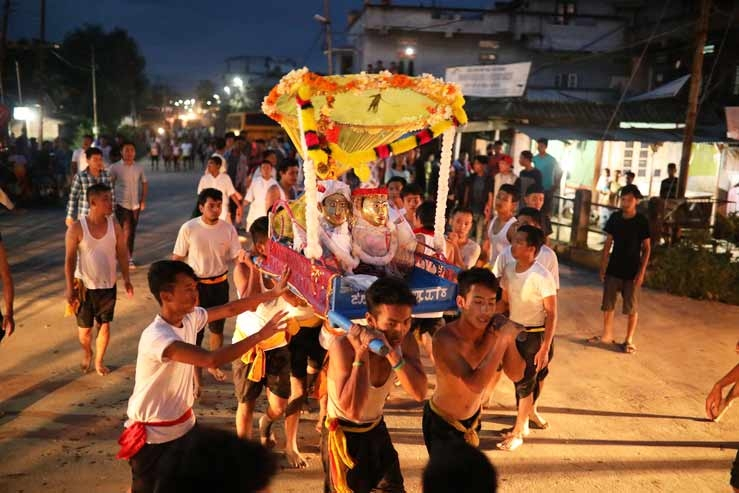
Lairoi Rituals
The Lairoi rituals are the concluding rites that mark the end of the ritual event. They are performed on the last day. On this day, the conclusion of the daily rituals is oriented not to closing of the day’s event but to closing the sacred time and space of the Lai Haraoba. The Lairoi set of rituals include thang jagoi (the dance with the blades), which is performed by a maibi in the four corners. It is oriented towards dispelling negative energies. Another is the loutaba (a reference to an agricultural context), popularly known as the Tangkhul-Nurabi with reference to the two mythological figures that have central significance in the said ritual segment. Unlike the other rituals, loutaba is more like a skit with a loosely structured script, and has elements of comical interludes, myths, sacred chants and play, with room for the performer to improvise. Some of the other rites are the ougri hangel, thawai mi-konba, sharit litpa, khencho chongba, to name a few. These rites are effectively in-gathering and closing-in rites.
The sacred presence is ritually let go with the rite of lai nongaba, which marks its departure from this world and ascent back to the other realm. A boat is ritually constructed for this journey. The uyarol lyrics describe the falling of the chosen tree in the forest while the songs of hijing hirao describe the making of the boat. The hymn of higa ishei marks the ascent. The ritual is completed with the singing of nongarol, the hymn for the ascent. On the return back to the shrine, the assemblage of sacred images and paraphernalia, constructed specifically for the event, is dismantled. This dismantling is systematic and ritualised. It takes place the same night. On this day a leihun offering of langthrei leaves is made. The doors of the shrine are closed and, for five days, it is left undisturbed. On the fifth day, the maibi returns to remove this offering and prepare a fresh one. This rite is called leihun tamba and marks the final rite of the Lairoi rituals.
Sports
Earlier, the day after the Lairoi was dedicated to sporting events. The events staged were different types of indigenous games, such as yubi lakpi (often compared to rugby, it involves a coconut and oiled bodies), kangjei (indigenous game of hockey), mukna (wrestling), mukna-kangjei (an indigenous game that incorporates elements of wrestling and hockey), thouri chingnaba (tug of war), etc. This aspect of Lai Haraoba is not given much emphasis in the festival as it exists today.
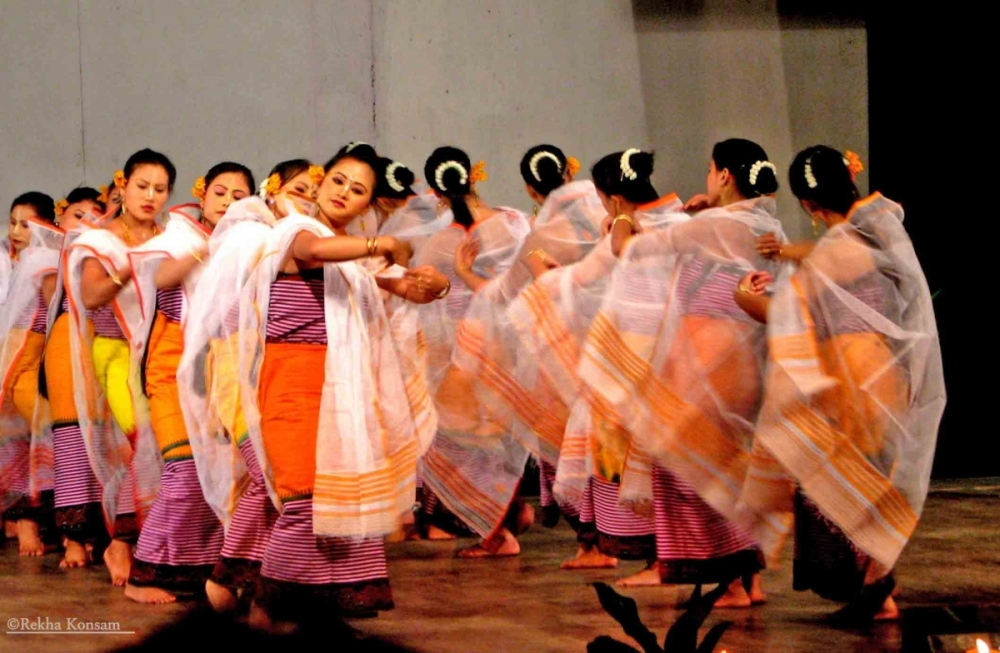
The Dance Tradition
The performative dance rituals of the Lai Haraoba have garnered much attention. While it has always been a crucial part of the dance traditions of the Meiteis, it was given a place in the world of dance performances through its introduction into the Jawaharlal Nehru Manipur Dance Academy (JNMDA) curriculum (Fig.14). With this initiative, the dances of the Lai Haraoba, which have been carried forward through traditional institutions, are now being brought into the purview of modern institutionally trained dances.
The Deities
Listed below are the names of the Umang Lai, as presented by Pt. Wahengbam Lukhoi Singh [2]:
|
1. |
Moirang Thangjing |
2. |
Heingang Marjing |
3. |
Sugnu Wangbarel |
4. |
Awang Sekmai Koubru |
5. |
Yaiskul Nongsaba |
|
6. |
Sugnu Lokningthou |
7. |
Sugnu Sanamahi |
8. |
Thanga Chingningthou |
9. |
Koirengei Pakhangba |
10. |
Maibamlokpaching Loyarakpa |
|
11. |
Top Chingkha Inamung |
12. |
Yairipok nongpok Panthoibi |
13. |
Kodompokpi Sorarel |
14. |
Yurembam Unam Sorarel |
15. |
Yambem Yairi Ningthou |
|
16. |
Tairenpokpi Koubru |
17. |
Phaknung Chingkhei Guru |
18. |
Awang Yumnam Khunou Puthiba |
19. |
Khurai Puthiba |
20. |
Wangu Wangbarel |
|
21. |
Ningel Nongpok |
22. |
Chandrakhong Yenkhurakpa |
23. |
Andro Panam Ningthou |
24. |
Andro Pureiromba |
25. |
Tangjeng Lokningthou |
|
26. |
Nungu Lokningthou |
27. |
Phayeng Koubru |
28. |
Nachou Sorarel |
29. |
Kha Potsangbam Panganba |
30. |
Ningthoukhong Oknarel |
|
31. |
Eething Thangjing |
32. |
Oinam Nongsaba |
33. |
Haobijam Chairellakpa |
34. |
Laishram Eereima |
35. |
Moirangthem Thangjing |
|
36. |
Tongbram Lairemma |
37. |
Salam Sorarel, Sanahal |
38. |
Heisnam Chingningthou |
39. |
Ngangkha Lawai Thangjing |
40. |
Maibram Tampak Lainingthou |
|
41. |
Laishangbam Nongsaba |
42. |
Philem Khoriphaba |
43. |
Laiphrakpam Khaanachaoba |
44. |
Khoyangbam Ayangleima |
45. |
Phairelbam Loklaoleima |
|
46. |
Ahanthem Sanamahi |
47. |
Mairenbam Leikoi Ningthou |
48. |
Kumam Maharaba |
49. |
Hemam Pakhangba |
50. |
Konjengbam Sorarel |
|
51. |
Kiyam Ui Ningthou |
52. |
Thongam Thongnang Ningthou |
53. |
Kumphi Santhong Ningthou |
54. |
Sagang Santhong Ningthou |
55. |
Kodompokpi Khoriphaba |
|
56. |
Patsoi Khunjao Pakhangba |
57. |
Patsoi Khunou Nongkabi |
58. |
Shachep Chingkhei Puri-Puraba |
59. |
Ukhongshang Nongpok |
60. |
Uyal Arong Ningthou |
|
61. |
Khoirom Nongpok Ninngthou |
62. |
Kharman Pakhangba |
63. |
Oinam Tangleihada Eereima |
64. |
Oinam Laipham Eereima |
65. |
Oinam Thingel Eereima |
|
66. |
Lamdeng Laikhurembi |
67. |
Lambal Koubru |
68. |
Changangei Khubomba |
69. |
Sharotkhaibam Phouoibi |
70. |
Wangkhei Laishram Eereima |
|
71. |
Wangjing Ningthou |
72. |
Lairen Sajik Koubru |
73. |
Tentha Eekop Ningthou |
74. |
Thoudam Eerong leima |
75. |
Khurai Konsam Leikai Chingjroibi |
|
76. |
Lamsang Eshing Chaiba |
77. |
Utlou Panthoibi |
78. |
Kiyamgei Pakhangba |
79. |
Chingamakha Soram Yumjao Lairemma |
80. |
Malom Khunjaoba |
|
81. |
Thoubal Sabal Tongba Thouban Ningthou |
82. |
Haoga Sorarel |
83. |
Kontha Marjing |
84. |
Phumlou Keiroi Koubru |
85. |
Phumlou Siphai Koubru |
|
86. |
Haoreibi Pakhangba |
87. |
Sarangthem Lairemma |
88. |
Leisangthem lairemma |
89. |
Heikrujam Loiyarakpa |
90. |
Leimapokpam Siphai Thangjing |
|
91. |
Leimapokpam Khunpham Sebu Leima |
92. |
Aarapti Pureiromba |
93. |
Awang Potsangbam Koubru |
94. |
Angom Yumjao Leima |
95. |
Langpok Ningthou |
|
96. |
Kangabam Yumjao Leima |
97. |
Potsangbam Thouriphi Koubru |
98. |
Keisampat Yumjao Leima |
99. |
Taobungkhok Loiyarakpa |
100. |
Pishum Huidrom Yumjao Leima |
|
101. |
Kairang Marjing |
102. |
Loitangkhunou Koubru |
103. |
Haorang Sabal Koubru |
104. |
Haorang Keirel Koubru |
105. |
Moitangpok Korouhanba |
|
106. |
Lamlai Pureiromba |
107. |
Yurembam Huidon Pokpi |
108. |
Wangoi Sanamahi |
109. |
Wangoi Wangbarel |
110. |
Patsoi Taomang Naothingkhong |
|
111. |
Patsoi Nongabi |
112. |
Chingamakha Eerom Yumjao Leima |
113. |
Sanjenbam Koubru |
114. |
Lamangdong Yangoi Ningthou |
115. |
Kwasiphai Pakhangba |
|
116. |
Thiyam Konjin Phunan Ningthou |
117. |
Kakching Khullen Khamlangba |
118. |
Kakching Khullen Naohal |
119. |
Kakching Khullen Eerum Ningthou |
120. |
Kakching Khullen Sekmai Ningthou |
|
121. |
Kakching Khoriphaba |
122. |
Wairi Khamlangba |
123. |
Arapti Eereima |
124. |
Eerengpal Eerum Ningthou |
125. |
Paonam Eeshing Chaiba |
|
126. |
Toubul Yangoi Ningthou |
127. |
Kangamung Khujoi Loiyarakpa |
128. |
Ngairangbam Loiyarakpa |
129. |
Waiton Puthiba |
130. |
Khundrakpam Marjing |
|
131. |
Tingri Marjing |
132. |
Sapam Solai Khongjom Ningthou |
133. |
Shalungpham Eekop Ningthou |
134. |
Thoubal Nonggangkhong Thoubal Ningthou |
135. |
Kekru Nongpok Panthoibi |
|
136. |
Chabung company Wangbrel |
137. |
Eeram Siphai Ngangourakpa |
138. |
Mutum Phiphou Eerong Leima |
139. |
Kakwa Naorem Panthoibi |
140. |
Iroisemba Thongamacha |
|
141. |
Naran Konjing Koubru |
142. |
Mayang Imphal Khuman Pokpa |
143. |
Lairenjam Lairemma |
144. |
Thangbijrou Thangba |
145. |
Meitram Shebu Leima |
|
146. |
Shagol Tongba Pakhangba |
147. |
Keinou Khulleima |
148. |
Thogam Mondung Khulleima |
149. |
Samram Khongjom Ningthou |
150. |
Lourembam Lairemma |
|
151. |
Konjengbam Lairemma |
152. |
Top Langmai Leima |
153. |
Thongam Panganba |
154. |
Thaoroijam Yumjao Leima |
155. |
Uripok Yurembam Huidom Pokpi |
|
156. |
Elangbam Panganba |
157. |
Mayengbam Yaoreibi |
158. |
Mayang Langjing Mamang Koubru |
159. |
Mayang Langjing Maning Koubru |
160. |
Langmeithet Panthoibi |
|
161. |
Khumbong Panthoibi |
162. |
Awang khunou Koubru |
163. |
Phoijing Chaning Leima |
164. |
Taothong Koubru |
165. |
Uripok Khamlangba |
|
166. |
Akham Khamlangba |
167. |
Uripok Laikhurembi |
168. |
Elangbam Khanapokpi Pangamba |
169. |
Luker Khoimom Lairemma |
170. |
Lamboikhul Eereima |
|
171. |
Govindagram Puthiba |
172. |
Khonghampat Luwangpokpa |
173. |
Khonghampat Koubru |
174. |
Parnam Khul Loiyarakpa |
175. |
Ngariyanbam Koubru |
|
176. |
Nambol Khoriphaba |
177. |
Phoukakchao Phouoibi |
178. |
Kha Thounaojam Panthoibi |
179. |
Uchekol Moriba |
180. |
Nambol Konkham Loiyarakpa |
|
181. |
Khundrakpam Panganba |
182. |
Meinam Lairemma |
183. |
Achanbigei Marjing |
184. |
Kangamung Maisnam Loiyarakpa |
185. |
Keirao Langdum Keirao Lakpa |
|
186. |
Wahengbam Yumjao Leima |
187. |
Tekcham Eekop Ningthou |
188. |
Langmeidomg Pakhangba |
189. |
Eengourok Nongpok Ningthou |
190. |
Heinoupok Loiyarakpa |
|
191. |
Chingamakha Maisnam Luwangpokpa |
192. |
Pukhao Ahallup Eereima |
193. |
Khurai Lai Awangba |
194. |
Wangbal Eekop Ningthou |
195. |
Hiyangthang Lairemma |
|
196. |
Huirem Chingbal Leima |
197. |
Naharup Pureiromba |
198. |
Pungdongbam Panthoibi |
199. |
Nungoi Puthiba |
200. |
Sagolband Pakhangba |
|
201. |
Lamding Wangjing |
202. |
Chingtham Khongjom Ningthou |
203. |
Ningthoukhong Thangnarel |
204. |
Yumnam Yumjao Lairemma |
205. |
Sagolmang Eereima |
|
206. |
Patpal Eerum Ningthou |
207. |
Nungu Laimanai |
208. |
Charangpat Mamang Arong Ningthou |
209. |
Khangabok Eekop Ningthou |
210 |
Pengi Arong Ningthou |
|
211. |
Moirangpurel Pashi Lairemma |
212. |
Pourabi Puthiba |
213. |
Khwai Lainingthouhanba |
214. |
Loktonbam Arai Leima |
215. |
Nakalbam Chingol Ningthou |
|
216. |
Khurai Mamang Yangoi Ningthou |
217. |
Khurai Angouba |
218. |
Khurai Puthiba |
219. |
Shoubol Lairemma |
220. |
Top Langmai Leima |
|
221. |
Sekta Laiyingthou Achangba |
222. |
Khangkhui |
223. |
Khurai Ningthem Pokpa |
224. |
Angom Pokpa (Leithong) |
225. |
Aton Khuman Pakhangba Ningthem pokpa |
|
226. |
Lamdeng Thumkhong Lairemma |
227. |
Lamdeng Poireiton Laikhurembi Leima Leinaotabi |
228. |
Luwang Guru Sangol |
229. |
Khagi Maibi Yumpham |
230. |
Thinungei Loyarakpa |
|
231. |
Thinunggei Ramji Ningthou |
232. |
Eethai Phouoibi |
233. |
Thangtek Yangoi Ningthou |
234. |
Ngairangbam Khunou Pakhangba |
235. |
Kha Yumnam Khunou Loiyarakpa |
|
236. |
Khurai Soubon Lairemma |
237. |
Uchekon Panthoibi |
238. |
Konthoujam Lairemma |
239. |
Takhel Nongpok Ningthou |
240. |
Pukhao Laipham Ireima |
|
241. |
Arong Phouoibi |
242. |
Pukhao Khabam Eereima |
243. |
Heibongpokpi Koubru |
244. |
Kongamung Tongbram Loiyarakpa |
245. |
Khathong Pakhangba |
|
246. |
Satpam Khongjom Ningthou |
247. |
Thokchom Arong Ningthou |
248. |
Athokpam Arong Ningthou |
249. |
Keirak Sekmai Ningthou |
250. |
Khurai Thareima |
|
251. |
Khaidem Loiyarakpa |
252. |
Heirok Eekop Ningthou |
253. |
Wabagai Pakhangba |
254. |
Lairen Kabi Koubru |
255. |
Chajing Lakpa |
|
256. |
Irengbam Nameirakpam Khubomba |
257. |
Khoijuman Yangoi Ningthou |
258. |
Ningom Shang Shang Ningthou |
259. |
Nongpok Lourembam Arong Ningthou |
260. |
Heisnam Panthoibi |
|
261. |
Oinam Sawongbung Eereima |
262. |
Thouban Ningonbam Thouban |
263. |
Kongpal Uraleima Ningthou |
264. |
Kongpal Puri Puraba |
265. |
Bamonkampu Pureiromba |
|
266. |
Tangkham Khulleima (Kalika) |
267. |
Charangpat Maning Nongpok Ningthou |
268. |
Khongjom Ningthou |
269. |
Ahallup Marjing |
270. |
Thongak Lairemma Langol |
|
271. |
Irengbam Khoriphaba |
272. |
Langol Kameng Koubru |
273. |
Kongpal Langmai Leima |
274. |
Wakharakpa |
275. |
Pangei Marjing |
|
276. |
Lamabam Eerongleimma |
277. |
Keirao Lakpa |
278. |
Khekman Langbren |
279. |
Khekman Pakhangba |
280 |
Khekman Leikairakpa |
|
281. |
Wangkheirakpa Yumjao Lairemma |
282. |
Shagolmang Eereima |
283. |
Meinam Lairemma |
284. |
Langmeidong Pakhangba |
285. |
Elangbam Panganba |
|
286. |
Meijrao Lakpa |
287. |
Lairenjam Lairemma |
288. |
Kyamgei Khagemba |
289. |
Kyamgei Mungyamba Pakhangba |
290. |
Salungpham Nongpok Ningthou |
|
291. |
Kabowakching Loiyarakpa |
292. |
Ningthoubung Puraba |
293. |
Kangamung Siphai Loiyalakpa |
294. |
Pangan Siphai Nungthelleimma |
295. |
Hiyanglam Panganba |
|
296. |
Phouden Pakhangba |
297. |
Phouden Nongpok Ningthou |
298. |
Heinoukhongnembi Laishram Lairemma |
299. |
Nongchup Sanjenbam Koubru |
300. |
Shamuroulakpa |
|
301. |
Shamuroulakpa Khwai Ningthou |
302. |
Shamuroulakpa Leitang Ningthou |
303. |
Morok Ingkhol Koubru |
304. |
Keinou Ahongshangbam Lairemma |
305. |
Keinou Thongthak Koubru |
|
306. |
Ngaikhong Yangoi Ningthou |
307. |
Karam Nongshaba |
308. |
Waheng Khuman Pakhangba |
309. |
Sagontongba Shuraisam Khagemba |
310. |
Soubam Mawao Leima |
|
311. |
Khaidem Nganuleima |
312. |
Maibakhul Marjing |
313. |
Maklang Nungthil Leima |
314. |
Heiyen Eekop Ningthou |
315. |
Hangun Kalipha |
|
316. |
Tera Khunou Eekop Ningthou |
317. |
Tentha Khunou Eekop Ningthou |
318. |
Sinam Kom Lainingthou |
319. |
Kabo Wakching Nongabi |
320. |
Keibi Eereima |
|
321. |
Langol Ningthou |
322. |
Tarung Leima |
323. |
Phubala Pakhangba |
324. |
Pechi Arong Ningthou Eekop Ningthou |
325. |
Thangmeiband Kanghujam Naothingkhong |
|
326. |
Khurai Lai Khurembi |
327. |
Charangpat Mayai Nongpok |
328. |
Laphupat Kalika |
329. |
Thamnapokpi Thangjing |
330. |
Sairem Khul Koubru |
|
331. |
Khabi Lairembi |
332. |
Waroi Ching Malang Humoiba |
333. |
Yaingangpokpi Haoreima Sambubi |
334. |
Nongpok Kameng Khamlangba |
335. |
Kakmayai Panthoibi |
|
336. |
Thongam Mondung Nungang Maharabi |
337. |
Kwarokching Tarang Saraba |
338. |
Ningol Phouoibi Lokchao Thanungba |
339. |
Chandrakhong Nongpok Sawang Lallam Phoriba |
340. |
Koirengei Pakhangba Khuman Pokpa |
|
341. |
Kongbamaru Konglouton Louthiba |
342. |
Koubru Inamung, Chandeba, Khongdeba |
343. |
Kaodrukna Koubru |
344. |
Khurkhul Ichum Lairemma |
345. |
Sekmai Wangbren |
|
346. |
Phayeng Sawang Soraren |
347. |
Leimaram Koubru |
348. |
Thongjao Mayang-ngamba |
349. |
Nung Santhong Pan Santhong Nungyungbi |
350. |
Chothe Thangwai Pakhangba |
|
351. |
Ngakchoupokpi Yangoi Ningthou |
352. |
Ishok Chingphu Ningthou |
353. |
Kha Lourembam Panthoibi |
354. |
Thiyam Laikom Pakhangba |
355. |
Sansenbam Panthoibi |
|
356. |
Pukhrambam Panthoibi |
357. |
Thounaojam Panthoibi |
358. |
Awang Jiri Kabokthong Lairemma |
359. |
Kha Potsangbam Panganba |
360 |
Naorem Panthoibi |
|
361. |
Pombikhok Loningthou |
362. |
Kondong Lairemma |
363. |
Chairen Khunbu Leima Khunmabi Panthoibi Tangkhul Huithok Pakhangba |
364. |
Nongmaijing Nongpok Apanba Khalongnachingba Laipham |
365. |
Kanto Khullel Koubru |
|
366. |
Kanto Khunou Koubru |
367. |
Tera Urak Koubru |
368. |
Pukhao Naharup Eereima |
369. |
Naharup Terapur Eereima |
370. |
Chajing Mairelkhong Puthiba |
|
371. |
Leimatak Pakhangba Hidel Pakhangba |
372. |
Project Mapal (phase-iv) Pakhangba |
373. |
Upokpi Sorarel |
374. |
Lamdong Makha Mayang-ngamba |
375. |
Heikrujam Mamang Loiyarakpa |
|
376. |
Heikrujam Mamang Khuman Pokpa |
377. |
Churachandpur Awang Makha Maikei-ngakpa |
378. |
Lairenjam Khoriphaba |
379. |
Bamdara Awang Machem Ching Chingthang Lairembi Machem |
380. |
Bamdara Makha Manao Ching Chingthasang Lairembi Manao |
|
381. |
Yurembam Matkha Moirangpokpa |
382. |
Atom Khul Nganu Leima |
383. |
Kadompokpi Maning Mekola Taoding Pakhangba |
384. |
Changangei Maning Poklen Pokpa |
385. |
Utlou Mamang Nongda Lairen Pakhangba |
|
386. |
Pangei Bazar Tangja Lil Pakhangba |
387. |
Khonghampat Khunou Koubru |
388. |
Mayang Imphal Konthak Wangba Sorarel |
389. |
Chongtham Konalakpa Pakhangba |
390. |
Takyel Lairembi |
Notes
[1] Arambam, Lokendro. 2002. ‘Some Aspects of Kanglei Lai Haraoba’, in Traditional Customs and Rituals of North-East India, Vol. 1, ed. P.C. Sharma. Guwahati: Vivekananda Kendra Institute of Culture, 149.
[2] Singh, W. Lukhoi. 2008. Lai Haraoba. Manipur: author
References
Arambam, Lokendro. 2002. ‘Some Aspects of Kanglei Lai Haraoba’, in Traditional Customs and Rituals of North-East India, Vol. 1, ed. P.C. Sharma. Guwahati: Vivekananda Kendra Institute of Culture.
Brara, N. Vijayalakshmi, 1998. Politics, society and cosmology in India’s North East. Delhi: Oxford University Press.
Chaki-Sircar, Manjusri, 1984. Feminism in a traditional society: women of the Manipur valley. Delhi: Shakti Books.
Chatterji, Suniti Kumar. 1974. Kirata-Jana-Kriti: The Indo-Mongoloids, their Contribution to the History and Culture of India. Calcutta: Calcutta Asiatic Society.
Konsam, Rekha. 2004. A Sociological Review of The Literature on a Religious Festival: Lai Haraoba. Unpublished M.Phil. dissertation. Department of Sociology, Delhi School of Economics, Delhi University.
Konsam, R. 2016. Cultural Contestation and the Public Space Within the Lai Haraoba in Manipur. Unpublished Ph.D. dissertation. Department of Sociology, Delhi School of Economics, Delhi University.
Levi-Strauss, Claude. 1970. The Raw and the Cooked. tr. Weightman, J. & Weightman, D. London: Jonathan Cate.
Parratt, S.N. 1980. The Religion of Manipur. Calcutta: Firma KLM (Pvt.) Limited.
Parratt, S.N. and J. Parratt. 1997. The Pleasing of the Gods: Meitei Lai Haraoba. New Delhi: Vikas Publishing House Pvt. Ltd.
Sanajaoba, N. (ed.). 1991. Manipur: Past and present – the ordeals of and heritage of a civilization, Vol. 2. New Delhi: Mittal Publications.
Shakespeare, J. 1913. ‘The Pleasing of the God Thangjing’. Man. XIII.1:112.
Singh, E.Nilakanta. 1982. Aspects of Indian Culture. Imphal: Jawaharlal Nehru Manipur Dance Academy.
Singh, E.N. 1997. Manipuri Dance. New Delhi: Omsons Publications.
Singh, Kh. Ratan. 2001. Lai Haraoba of Manipur: Indigenous Festival of the Meitei (A Social-Historical Perspective). Manipur: Smt. Pratima Devi
Singh, L. Bhagyachandra. 1987. A Critical Study of the Religious Philosophy of the Meitei Before the Advent of Vaishnavism in Manipur. Manipur: L. Momon Devi
Singh, W. Lukhoi. 2008. Lai Haraoba. Manipur: author
[i] Khoriphaba is the name of one of the deities.
